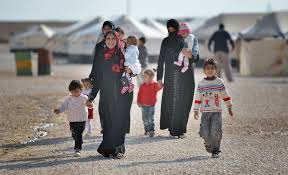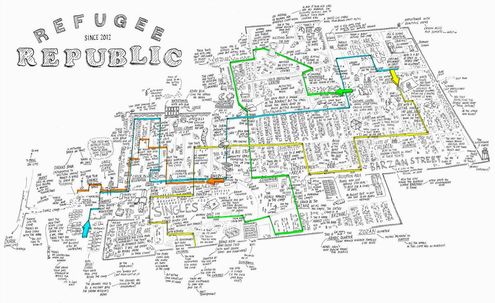For more information, click the button to go to the UNHCR Emergency Handbook
For a detailed guide on planning and constructing a refugee camp, click the button below
Use this chart to understand the vocabulary used throughout the webpage
Residential Guidelines
When designing a refugee camp, it is important to comply to all of the UNHCR residential requirements. All of the following information is the minimum requirement for each subject, and can be exceeded for higher quality living conditions. Something interesting stated in the information below is not the fact that the latrines (toilets) have to be within 50 m from each living space, but that they cannot be closer than 6 m. i find this interesting because i think it is very considerate of those living in the houses/ tents closest to the latrines; because no one wants their living space to be touching the restroom.
- Camp Site Requirements
- Water
- Supply - 20 liters per person
- Tap Standard - 1 per 80 persons/ one per community
- Water Distance - 200m max from household
- Latrine
- Communal Latrine - 1 per 20 persons
- Latrine Distance - must be between 6m- 50m from any household
- Shower
- Shower - 1 per 50 persons
- Trash
- Trash container - 1 100 L container per 50 persons
- Water
- Emergency Standards
- Covered Living Area
- 3.5 sqm. Per person minimum
- For cold climates and urban areas, 4.5 sqm. To 5.5 sqm. Is more appropriate
- Minimum ceiling height of 2m at highest
- Camp Settlement Size
- 45 sqm. Per person (include kitchen and vegetable garden)
- Fire Safety
- 30m firebreak every 300m
- Minimum 2m between structures - use 2 times the height of the structure as an appropriate distance
- Gradient For Camp Site
- 1 to 5%, ideally 2 to 4%
- Drainage
- Appropriate drainage needs to be put in place, especially relevant in locations that experience a rainy season or flash floods
- Covered Living Area
Commercial Guidelines
The UNHCR has basic requirements for what a refugee center should contain for the basic needs of the refugees. These requirement are held on the basis of how ever many people are being housed. An example for this is that at minimum you need a school for every 5,000 people. These requirements keep a humane stance on how the life in a refugee center can stay somewhat close to normal.
|
Here is the Infromation from the UNHCR website talking about the very minimum ratio and the considerations to make it more then minimum. Check Link for full chart:
- Rubbish container of 100 litres: 1 per 50 persons or 1 per 10 families - Refuse pit – 2mx5mx2m: 1 per 500 persons or 1 per 100 families - Health centre: 1 per 20,000 persons or 1 per settlement, Include water and sanitation facilities - Referral hospital: 1 per 200,000 persons or 1 per 10 settlements - School: 1 per 5,000 persons or 1 per sector, 3 classrooms, 50 Sqm. - Distribution centre: 1 per 5,000 persons or 1 per sector - Market place: 1 per 20,000 persons or 1 per settlement - Feeding centre: 1 per 20,000 persons or 1 per settlement - Storage area: 15 to 20 Sqm. per 100 persons or Refugee storage - Lighting: As appropriate, Consider priority locations such as latrine, wash areas, public service areas - Registration area: As appropriate, May include arrivals area, medical clearance, distribution, parking - Administration / office: As appropriate - Security post: As appropriate - Security fencing: Depending on the circumstances |
Click to Access Interactive Version
|
Security Guidelines
Food Security
Food security in refugee camps is crucial to having a safe operation. In refugee camps, food security is defined as maintaining the health and nutrition camp residents. In order to have sufficient security, the camp should use the food effectively, from the amount of food given top each person, to the quality of the food. A safe area to consume food is also very crucial in having good food security. Dining halls and specific eating areas that are extra sanitary should be a priority. Lastly, providing safe transportation means the food will be safe. Often times, food is checked before it even enters the camp. Camp officials often check for expired foods or other foods that do not meet traditional food standards.
Food security in refugee camps is crucial to having a safe operation. In refugee camps, food security is defined as maintaining the health and nutrition camp residents. In order to have sufficient security, the camp should use the food effectively, from the amount of food given top each person, to the quality of the food. A safe area to consume food is also very crucial in having good food security. Dining halls and specific eating areas that are extra sanitary should be a priority. Lastly, providing safe transportation means the food will be safe. Often times, food is checked before it even enters the camp. Camp officials often check for expired foods or other foods that do not meet traditional food standards.
Shelter Security
Safety in refugee camps is a very serious topic. The refugees are in very unstable situations and are familiar with almost nothing. To add onto that, they are most likely within miles of war zones. While safety from the war is already being addressed, there are other factors that must be addressed. While working at a refugee camp, it is important to maintain relationships and discussions with all refugees. It is important to highlight conversations that call for a security concern. Additionally, it is important to maintain medical safety with patients. Ensuring that patients have no communicable diseases and providing proper medical care is crucial to having a safe refugee camp. One of the most important concerns is safety from the outside. Proper fencing should secure the property, along with a security checkpoint at the entrance to the camp. Lastly, a basic rule of thumb is that all refugee camps should be located at least 50km from the nearest country border or the nearest conflict zone.
Safety in refugee camps is a very serious topic. The refugees are in very unstable situations and are familiar with almost nothing. To add onto that, they are most likely within miles of war zones. While safety from the war is already being addressed, there are other factors that must be addressed. While working at a refugee camp, it is important to maintain relationships and discussions with all refugees. It is important to highlight conversations that call for a security concern. Additionally, it is important to maintain medical safety with patients. Ensuring that patients have no communicable diseases and providing proper medical care is crucial to having a safe refugee camp. One of the most important concerns is safety from the outside. Proper fencing should secure the property, along with a security checkpoint at the entrance to the camp. Lastly, a basic rule of thumb is that all refugee camps should be located at least 50km from the nearest country border or the nearest conflict zone.










